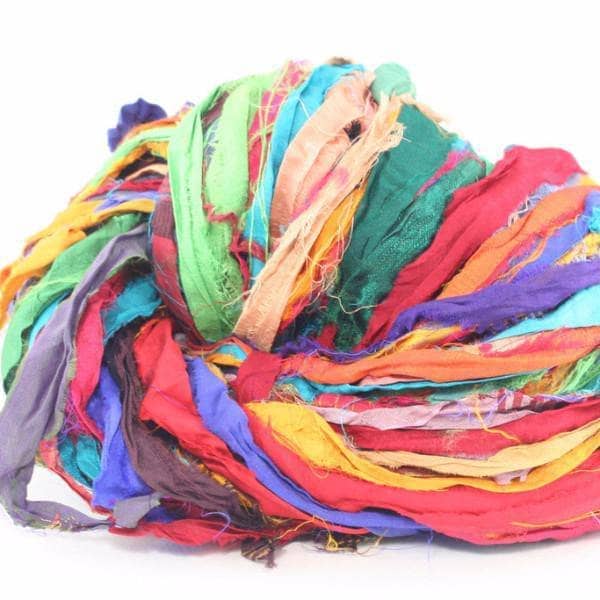Have you been wondering what all the hype is about silk? Have you been wanting to incorporate silk into your crafting but haven't been sure how? Here are a few interesting facts about one of DGY's most beloved fibers!

Is silk warm or cool?
Silk is a great insulator, it is specially created by silk worms to keep them safe and their temperature regulated during their metamorphosis. What that means for this natural fiber is versatility, silk can keep you warm in the winter (though not quite as warm as wool), and breathably cool in the summer (though maybe not as cool as cotton). This means silk is a great fiber to use in layering garments or transitional pieces to carry you from one season to the next.
Is silk annoying to wash?
Silk is not as delicate as we may think, after all most of the processes to prepare silk use hot or even boiling water. We ALWAYS recommend working up a swatch of your silk and sending it through your preferred wash method just in case! It is often recommended to dry clean silk because the hot water of a typical wash might make the colors or dyes run. To see if the colors on your silk will run or bleed, take an unnoticeable area of your silk item and dip it into some warm water. If you see any color go into the water you know your silk will bleed when washed, and can decide whether it’s best to wash or to dry clean your piece. It is true that a saturated or waterlogged silk fiber is weaker and more prone to breakage than a dry one, but most silk is tough enough to go in the washing machine on a delicate cycle, in a mesh bag, with mild soap. Hand washing is a great way to care for silks, using mild soap (detergents meant to break down proteins are great for getting egg off a cotton shirt, but they'll eat through silk fibers) and being sure to press out excess water rather than wringing the piece. Using cool water is important whether washing by hand or machine because it will make the dyes less prone to running (though it won’t stop them entirely). Keep in mind that the effects of the washing process can be a bit unpredictable, washing can alter the texture of silk and make something that was nice and smooth, textured to the touch. We definitely recommend laying your silk flat to dry, regardless of how it's washed. Of course, all of this depends on the silk you have, I definitely recommend making a swatch from your silk and washing it how you intend to wash the finished object, to see what the results will be for you (just another good reason to swatch). When in doubt, dry cleaning is the safest way to go. If you have the ability to experiment however, it’s easy to find out what works best for each piece!

Silk seems so strong, how do I make my silk items stay looking fresh for a long time?
Though silk is super strong, it does have a couple weaknesses as well. Silk is weakened by sunlight, it’s important to put your silks into a dark place when not in use so they don’t accumulate extra wear and tear. Dirty silk is also more prone to being nibbled on by little pests, in just the same way that wool and other protein fibers are. Thus, it’s important to clean silk as needed. Whenever your silk becomes smelly, or noticeable marks appear it’s a good idea to clean the silk, any next-to-skin articles should be cleaned regularly as well.
What are some characteristics of silk, related to the fiber arts specifically?
Have I said it enough yet? Silk is such a neat fiber! One of the coolest things about silk is that it can be shiny and lustrous, but it isn't slippery in the way the acrylic fibers can be. This makes silk really unique to knit or crochet with. Because silk doesn’t slip against itself, it’s very easy to work cables without a cable needle, do color work, or pick up dropped stitches in the work. Because it isn’t slippery, your knit or crocheted silk won’t ladder down or unravel very quickly, but because it’s so smooth, frogging something back is a breeze! Silk has almost no elasticity, and has a wonderful drape. This means that silk doesn’t have the same memory as a fiber like wool, when a piece is stretched or manipulated, it won’t spring back into shape on its own. However, this quality makes silk a perfect choice for anything lacy or drapey. One thing to pay a little extra attention to when working with silk yarns is tension. Keeping the yarn tensioned loosely in the hand is ideal to avoid aches and pains due to silk’s inelasticity. Silk won’t keep your secrets either, if the tension in your project is a little wonky it’ll show through in the final product. Silk can be a great alternative fiber for those who have allergies to wool or other animal fibers. It can also be a wonderful option for people with sensitive skin and are looking for a natural and incredibly soft fiber!
Are you ready to try out some silk? Or to try making a garment form silk? Let us know, and keep us updated on your progress in our facebook group!
P.S. I LOVE working with small weight yarns and threads, I also LOVE historical knitting and crochet. If anyone else has the same weird interests as me, you might be interested in checking out this damask silk KNIT shirt. Talk about gauge envy!
 Rewards
Rewards





















